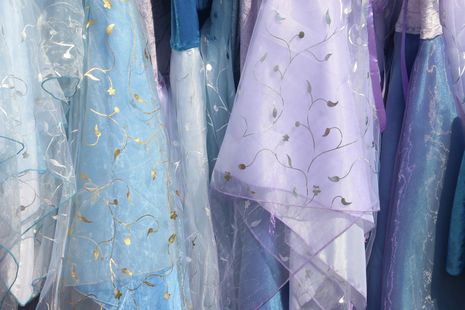Stop buying clothes
We have access to wider variety of clothes at a lower price than ever before. But at what point is enough enough?

It wasn’t all that long ago that the common person owned three, maybe four outfits. A hundred years ago, there simply wouldn’t have been a need for any more clothing than that. There was the outfit they wore to work; their casual clothes that they’d wash and wear again every day; the outfit they wore for special occasions; a quaint nightgown to sleep in if they were lucky. With clothes all being made by hand and priced according to the materials and labour that went into them, even the simplest garments were out of reach for the common person. Overindulgence was a trait of the aristocrats, the wealthy. Embroidered petticoats, shiny ruby heels and ornate hats with a circumference rivalling the Earth itself — these all existed only within the domain of the rich.
“We have graduated from the ancient ideal of clothes being something you wear. Now, clothes are who you are”
Today, the common person has an entire wardrobe full of clothes. We produce one hundred billion garments a year for a world that has just under eight billion humans. Almost a hundred million tonnes of those clothes end up as landfill — never worn, never cherished. Living in a highly individualistic society, where the expression of one’s identity seems to take precedence over all else, we have graduated from the ancient ideal of clothes being something you wear. Now, clothes are who you are. Overconsumption has become a mask for those who lack a sense of self, and the Earth pays the consequence for our shallow needs as human beings. People believe that they are entitled to massive, sprawling wardrobes fit for a king, filled to the brim with clothes that are cheap enough that they’d likely disintegrate in the sun. They believe that the unethically produced Primark jumpers are their “only option” because they’re cheap. Affordable. But a hand-made jumper made from a fabric other than polyester is deemed “overpriced”. Those who choose to support local, independent designers are deemed “frivolous”, as if it were worse to be frivolous than complicit in the rampant exploitation of overworked and underpaid workers.
“Even then, the solution isn’t for designers to undercut themselves in the name of accessible fashion”
“Frivolous” in itself isn’t even an apt description — to describe paying designers their worth as “frivolous” speaks to the fact that we as a nation are tainted by capitalism to the point that we don’t even recognise the value of clothes anymore. A designer pours their hard-earned funds into high-quality fabrics, toils away for countless hours for days on end to produce a single garment set at a price lower than its true value and is faced with consumers who say “this is too expensive, I could get the same thing at Primark”. It’s true. There’s only so much money to go around when there’s bills to pay and mouths to feed. Even then, the solution isn’t for designers to undercut themselves in the name of accessible fashion. The solution isn’t to promote exploitation as an “accessible” option. The solution, as the late Vivienne Westwood so aptly put it, is to buy less, choose well and make it last.
The world of fashion is shrouded by delusions of exorbitant wealth, when in reality, many designers struggle to make ends meet, barely working above the profit margin and sacrificing everything they have to bring their vision to life. Garment workers are viewed as disposable, paid in literal pennies and worked down to the bone. Most people in the world of fashion are just above broke, and yet, their suffering — their pain — remains unheard by the masses. While it is common practice to decry the exploitation of academics and minimum wage workers — as the numerous picket lines and protests around Cambridge will surely indicate — many people develop selective blindness when it comes to exploitation within the fashion industry. The devaluation of fashion as an art form means that the exploitation faced by those who work within the sector of fashion is viewed as less important, even ‘necessary’ since fast fashion allows us to mirror celebrity trends without a celebrity bankroll. Proclaiming the ills of inequality only to then feed into the consumerist ideal that “more is better” and buy clothes that, quite frankly, we don’t need. And as for the wealthy? They are as overindulgent now as they were a hundred years ago — arguably even more so now that rampant celebrity culture has granted them a worldwide audience to pander to. They are the leaders and we, desperate to emulate them and their status, follow suit.
As the neglected child will burn down an entire village to feel its warmth, the wannabe “it girl” with a fragile sense of self will watch the entire world burn for the barely perceptible warmth of cheap, thin garments that reflect a style that isn’t even theirs. And so the story goes.
 News / Cambridge students set up encampment calling for Israel divestment6 May 2024
News / Cambridge students set up encampment calling for Israel divestment6 May 2024 News / Cambridge postgrad re-elected as City councillor4 May 2024
News / Cambridge postgrad re-elected as City councillor4 May 2024 News / Proposed changes to Cambridge exam resits remain stricter than most7 May 2024
News / Proposed changes to Cambridge exam resits remain stricter than most7 May 2024 News / Some supervisors’ effective pay rate £3 below living wage, new report finds5 May 2024
News / Some supervisors’ effective pay rate £3 below living wage, new report finds5 May 2024 Fashion / Class and closeted identities: how do fits fit into our cultures?6 May 2024
Fashion / Class and closeted identities: how do fits fit into our cultures?6 May 2024





